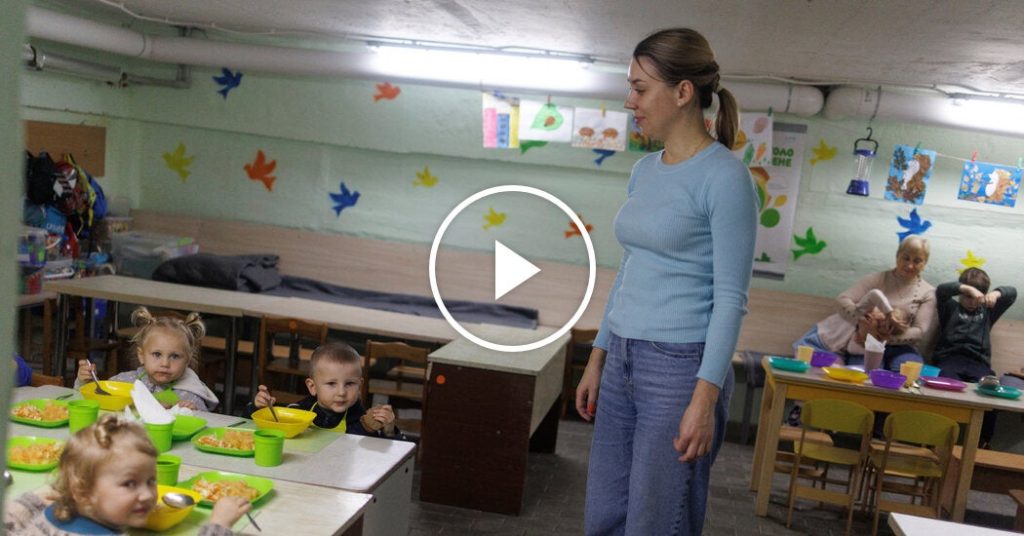Ukrainian Daycare Struggles Against the Dark: Power Crisis Threatens Children’s Warmth and Safety
As Winter Approaches, Russian Strikes on Energy Infrastructure Leave Vulnerable Communities in Peril
In the heart of Ukraine, where frost has begun to crystallize on morning windows, the children of a local daycare center huddle together under blankets during their afternoon nap time. Their sleeping arrangements aren’t just for comfort—they’re a necessity in a building where reliable heat has become a luxury. For Nataliya Kovalenko, the daycare director, this scene represents the heartbreaking “new normal” for Ukraine’s youngest citizens as the country enters its fourth winter under the shadow of Russia’s full-scale invasion.
“We used to worry about having enough art supplies or whether children remembered their mittens,” Kovalenko explains as she adjusts a battery-powered lamp in the dimly lit playroom. “Now we calculate how many hours of electricity we might have each day and whether our generator fuel will last through the week.” Her daycare, once a bright and warm haven for working parents, has transformed into a microcosm of Ukraine’s broader energy crisis—a crisis deliberately engineered through Russian military strategy that has systematically targeted the country’s power infrastructure since 2022.
Russia’s Systematic Destruction of Ukraine’s Energy Grid Enters a New Phase
The tactical assault on Ukraine’s energy system follows a grimly predictable pattern. As autumn leaves begin to fall each year, Russian strikes on power plants, transmission stations, and electrical infrastructure intensify dramatically. Military analysts describe this as a calculated campaign to make the harsh Ukrainian winter unbearable for civilians, potentially breaking national morale and creating humanitarian emergencies that strain already limited resources. According to Ukraine’s Energy Ministry, over 60% of the country’s power generation capacity has been damaged or destroyed since the invasion began, with repairs frequently targeted shortly after completion.
“What we’re witnessing is unprecedented in modern warfare,” explains energy security expert Oleksandr Kharchenko. “The deliberate and systematic destruction of civilian energy infrastructure constitutes a clear violation of international humanitarian law, yet the attacks continue with increasing precision.” Recent satellite imagery confirms significant new damage to thermal and hydroelectric facilities across Ukraine, with critical transformer stations—the vital nodes that distribute electricity across regions—receiving particular attention from Russian guided missiles and drones. The timing couldn’t be more deliberate, coming just as temperatures begin their annual plunge toward freezing.
Daily Challenges: How One Daycare Adapts to Survive
Inside Kovalenko’s daycare, the consequences of these distant explosions manifest in immediate, practical challenges. The kitchen staff begins preparing lunch before dawn, knowing that scheduled power outages might leave them unable to cook during normal hours. A small generator, donated by an international aid organization, powers essential services but cannot meet heating demands. Parents drop off children wearing multiple layers of clothing that remain on throughout the day. Staff members have become adept at creating engaging activities that require neither electricity nor significant warmth—puppet shows performed by flashlight, singing circles, and physical games that keep small bodies moving and warm.
“We’ve created our own routines around the blackouts,” says Maryna Petrenko, a teacher who has worked at the center for seven years. “When the lights go out, the children know to gather in the central room where it’s warmest. We’ve turned it into a game called ‘huddle time’ rather than letting them feel frightened.” Yet despite these adaptations, the situation remains precarious. The daycare’s water supply, dependent on electric pumps, functions only intermittently. Food requiring refrigeration must be carefully rationed. Most concerning to the staff is the building’s temperature, which sometimes drops below 55°F (13°C) during extended outages—dangerously cold for young children sitting still during learning activities.
Wider Humanitarian Impact: Children Bearing the Burden of War
The plight of this single daycare reflects a broader humanitarian crisis affecting Ukraine’s 3.6 million children under age six. UNICEF reports that approximately 1,500 educational facilities for young children have sustained damage during the war, with countless others struggling to operate amid energy shortages. The consequences extend beyond immediate physical discomfort. Pediatric psychologists warn of increasing developmental and emotional issues among young children exposed to prolonged cold, darkness, and the stress transmitted from worried adults around them.
“Children are remarkably resilient, but they’re not impervious to these conditions,” explains Dr. Kateryna Shevchenko, a child psychologist working with affected communities. “We’re documenting increased anxiety, sleep disturbances, and regression in developmental milestones among children in areas with severe energy problems. The constant uncertainty about whether basic needs will be met creates a chronic stress response that can have long-term consequences.” Particularly concerning are reports that some families have resorted to keeping children home from educational facilities altogether, either because the buildings cannot maintain safe temperatures or because they fear their children traveling during potential air raids triggered by the very attacks causing the power outages.
International Response and the Quest for Sustainable Solutions
As Ukraine battles to maintain essential services, the international community has mobilized significant resources toward energy resilience. The European Union has expedited delivery of power equipment, including industrial-scale generators, transformers, and specialized repair components worth over €1.5 billion. Private donations have funded thousands of smaller “points of invincibility”—community centers equipped with heat, charging stations, and internet access where citizens can warm themselves during extended blackouts. Yet experts warn that these measures, while critical, represent temporary bandages on a systemic wound.
“What Ukraine truly needs is comprehensive grid modernization with built-in redundancy and decentralized generation capacity,” says Viktoriia Lysenko of the International Energy Agency. “The current centralized system, largely inherited from Soviet times, creates single points of failure that make the entire grid vulnerable.” Some progress toward this vision is emerging. Several Ukrainian cities have begun installing solar panels with battery storage on critical infrastructure buildings, including hospitals, schools, and daycare centers. Meanwhile, engineers work around the clock to repair damaged infrastructure, often risking their lives as Russia frequently targets the same facilities multiple times.
The Children Who Refuse to Surrender to Darkness
Back at the daycare, as afternoon fades toward evening, parents arrive to collect their children in what has become a carefully orchestrated process timed around transportation availability and the security situation. Despite the challenges, Director Kovalenko and her staff remain determined to provide not just physical care but also normalcy and hope. Christmas decorations, crafted from recyclable materials that require no electricity to create, adorn the walls. Children’s artwork depicting sunny days and brightly lit homes creates a poignant contrast to the actual dimness of the rooms.
“These children deserve their childhood,” Kovalenko states firmly, helping a small boy into his coat. “Every day we operate, every smile we preserve, is an act of resistance against those who would plunge us into cold and darkness.” As she speaks, the power unexpectedly returns to the building. The children cheer spontaneously as lights flicker on, their faces illuminated with genuine delight at what was once taken for granted. No one knows how long the electricity will last—perhaps minutes, perhaps hours—but in this moment, the simple gift of light and warmth feels like a profound victory. It’s these small triumphs, repeated in thousands of homes and facilities across Ukraine, that sustain a nation as winter approaches and the energy war intensifies.












